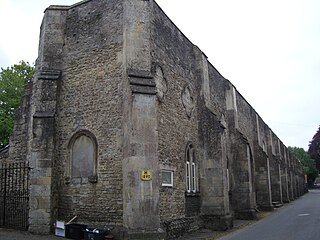St Neots Priory was a Benedictine monastery beside the town of St Neots in the historic county of Huntingdonshire, now a non-metropolitan district in the English county of Cambridgeshire.

The Tironensian Order or the Order of Tiron was a medieval monastic order named after the location of the mother abbey in the woods of Thiron-Gardais in Perche, some 35 miles west of Chartres in France). They were popularly called "Grey Monks" because of their grey robes, which their spiritual cousins, the monks of Savigny, also wore.

Alien priories were religious establishments in England, such as monasteries and convents, which were under the control of another religious house outside England. Usually the mother-house was in France.

The Abbey of Saint-Étienne, also known as Abbaye aux Hommes by contrast with the Abbaye aux Dames, is a former Benedictine monastery in the French city of Caen, Normandy, dedicated to Saint Stephen. It was founded in 1063 by William the Conqueror and is one of the most important Romanesque buildings in Normandy.
Folkestone Priory was a pre-Reformation Benedictine monastery at Folkestone in the English county of Kent. The priory church survives as the present parish church. It was the successor to Folkestone Abbey, an Anglo-Saxon nunnery on a different site.

Bruton Abbey in Bruton, Somerset was founded as a house of Augustinian canons in about 1127, and became an abbey in 1511, shortly before its dissolution in 1539. It was endowed with manors, churches and other properties in the area and also in Normandy in France.
Robert de Grantmesnil also known as Robert II, was a Norman nobleman; a member of a prominent Norman family. He first became a monk, then abbot at the Abbey of Saint-Evroul in Normandy and later Bishop of Troina in the Norman Kingdom of Sicily.

The Abbey of Sainte-Trinité, better known as the Abbaye aux Dames, is a former Benedictine nunnery in Caen, Normandy, now home to the Regional Council of Normandy. The complex includes the Church of Sainte-Trinité.

Ouche Abbey or the Abbey of Saint-Evroul is a former Benedictine abbey in Normandy, located in the present commune of Saint-Évroult-Notre-Dame-du-Bois, Orne, Normandy. It has been classified as a Monument historique since 1967 and is designated "classé".

The Abbey of the Holy Trinity at Fécamp, commonly known as Fécamp Abbey, is a Benedictine abbey in Fécamp, Seine-Maritime, Upper Normandy, France.
Humphrey de Vieilles was the first holder of the "grand honneur" of Beaumont-le-Roger, one of the most important groups of domains in eastern Normandy and the founder of the House of Beaumont. He was married to Albreda or Alberée de la Haye Auberie.

Stogursey Priory, also called Stoke Courcy Priory or The Priory of St Andrew de Stoke, was a Benedictine alien priory dedicated to St Andrew at Stogursey in Somerset, England. It was founded by William de Falaise, around 1100, to become a cell of Lonlay-l'Abbaye in Normandy. In around 1185 John de Courcy, its hereditary patron, founded the Priory of the Ards (Blackabbey) in County Down, Ireland, making an endowment of that estate to Stogursey Priory. The priory church survives as the parish church, and contains some of the original Norman architecture. Many of the priory's muniments are held in the archives of Eton College, which King Henry VI endowed with the appurtenances when the house was dissolved in about 1440.

Pamber Priory is a Church of England parish church and former priory, then known as West Sherborne Priory or Monk Sherborne Priory, at Monk Sherborne in the English county of Hampshire.
Horsley Priory was a medieval, monastic house in Gloucestershire, England.

Monks Kirby Priory was a Benedictine priory established in 1077 in Monks Kirby, Warwickshire, England. The priory was suppressed in 1415 when its estates and revenues were given to the Carthusian priory of Axholme in Lincolnshire, in whose possession they continued until the Reformation. Remains of the priory form part of Monks Kirby village church today.

Grestain Abbey was an 11th-Century Benedictine monastery near the town of Fatouville-Grestain, which is located in the modern-day Eure département of Upper Normandy, France. The abbey was in the Catholic Diocese of Lisieux. Closely associated with the family of William, Duke of Normandy, the abbey was instrumental in the Normans taking control over the Church in England in the centuries following the Norman Conquest of England, establishing new churches and priories in England, and Abbots of Grestain ordained many English priests. Many churches mentioned in the Domesday Book of 1086 cite Grestain as the founding establishment.

Morville Priory was a small Benedictine monastery in Shropshire, England, a cell of Shrewsbury Abbey.

Cerisy Abbey, otherwise the Abbey of Saint Vigor, located in Cerisy-la-Forêt, Manche, France, was an important Benedictine monastery of Normandy.

Bernay Abbey was a Benedictine abbey in Bernay, Eure, France. The designers of its abbey church were ahead of their time, making it one of the first examples of Romanesque architecture in Normandy. It shows the early evolution of that style, its decorative elements and its building techniques.

Saint-Gabriel-Brécy Priory was a Benedictine priory 10 km from the coast between Caen and Bayeux. It is sited in the town of Saint-Gabriel-Brécy, Calvados, France. A 13th century gate-tower survives, with ogive vaulting on sculpted capitals. It was adjoined by a now-lost guesthouse. The cornice is sculpted with small three-point arches. The vaulted refectory dates to the late 13th century. A keep was built to serve as a prison in the 15th century, whilst the Renaissance-style courtroom was built towards the end of the 16th century. A dovecote is now lost.













